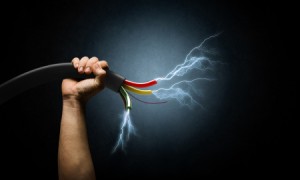Three of the top ten OSHA electrical safety violations are electrical in nature; in addition 5% of all on the job fatalities are due to improper interaction with electricity, proving that electrical hazards are a literal force to be reckoned with and require the proper attention from safety managers when assessing facility safety programs.
Here are 10 electrical safety tips to keep in mind when protecting your workers from electrical hazards.
- Electrical Safety is important, any workplace and position can be affected by electricity. Before you begin your day make note of any electrical equipment you may come in contact with and ensure that it is properly grounded before use.
- Standing in any type of wetness while using an electrical device of any kind is not a good idea. Try to avoid it whenever possible, this includes power tools, tablets, mobile phones, etc.
- Assume power lines are always energized whenever your works brings you to an area where you need to be around them. Use non-conductive materials, and tools when near them.
- A standard operating procedure in electrical safety to bring any machine being worked on to complete zero, fully de-energized before beginning repair or services.
- After bringing a machine to complete zero for servicing, always use proper lock out protocol to prevent co-workers from re-energizing a machine while it is being worked on.
- Never wear rings, watches, wristbands, or use metallic pencils or rulers while working with electrical equipment.
- Ask can this job be completed with one hand? Only using one hand to work reduces the chances of electricity going through the chest cavity in the event of an accident.
- If a spill happens on or near a machine do not try to clean it up. Shut the machine down completely and unplug it.
- Never touch electrical equipment unless you are specifically instructed to do so. It is advisable to consider the use of electrical safety signs, and make sure your hands are not wet or sweating and as precaution use the back of your hand if possible.
- The NFPA 70E Requirement were just made in 2015, refer to the changes to see what your facility should now be doing differently to ensure maximum workplace electrical safety.


